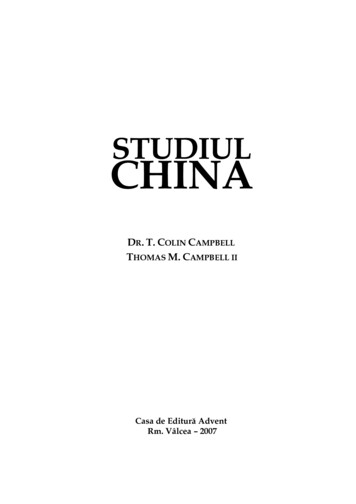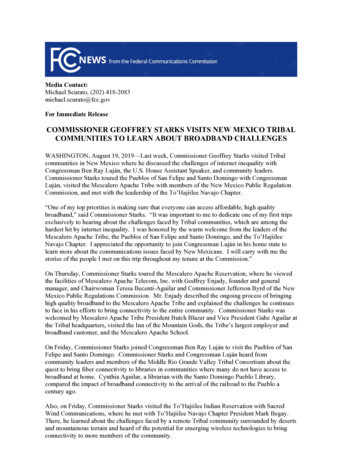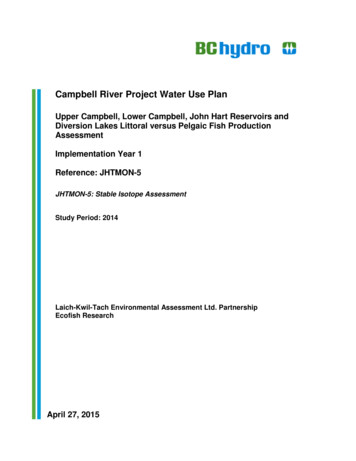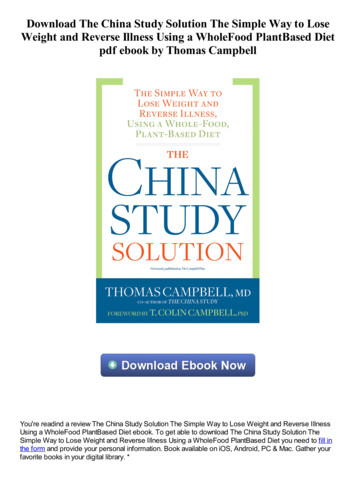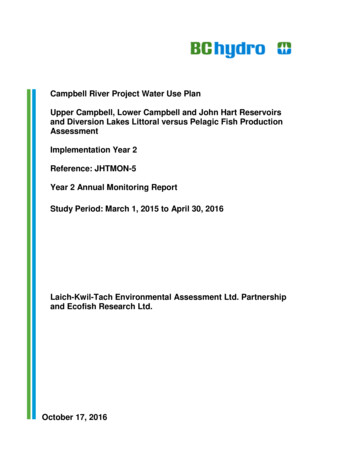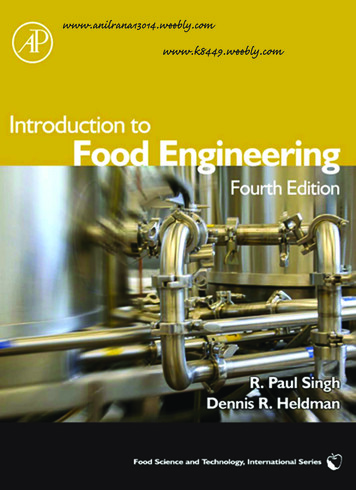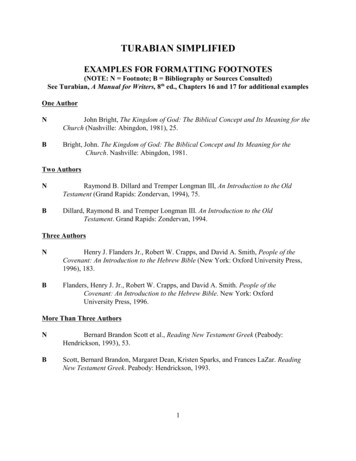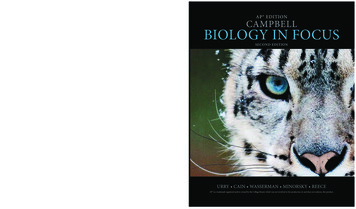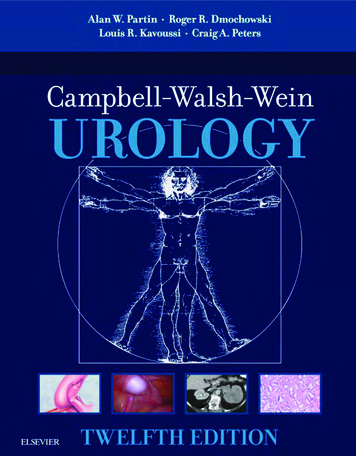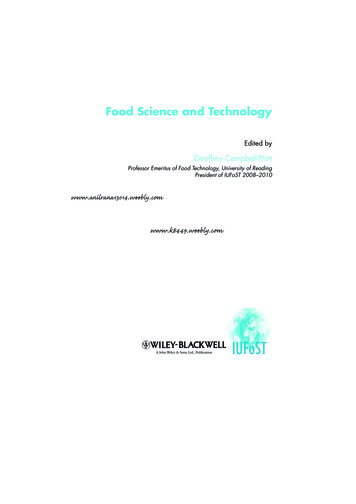
Transcription
BLBK179-Campbell-PlattJune 29, 200911:45Food Science and TechnologyEdited byGeoffrey Campbell-PlattProfessor Emeritus of Food Technology, University of ReadingPresident of IUFoST eebly.comA John Wiley & Sons, Ltd., Publicationiii
BLBK179-Campbell-PlattJune 29, 200911:45Food Science and Technologyi
BLBK179-Campbell-PlattJune 29, 200911:45ii
BLBK179-Campbell-PlattJune 29, 200911:45Food Science and TechnologyEdited byGeoffrey Campbell-PlattProfessor Emeritus of Food Technology, University of ReadingPresident of IUFoST 2008–2010A John Wiley & Sons, Ltd., Publicationiii
BLBK179-Campbell-PlattJune 29, 200911:45This edition first published 2009 C 2009 Blackwell Publishing LtdBlackwell Publishing was acquired by John Wiley & Sons in February 2007. Blackwell’s publishing programme has been mergedwith Wiley’s global Scientific, Technical, and Medical business to form Wiley-Blackwell.Registered officeJohn Wiley & Sons Ltd, The Atrium, Southern Gate, Chichester, West Sussex, PO19 8SQ, United KingdomEditorial offices9600 Garsington Road, Oxford, OX4 2DQ, United Kingdom2121 State Avenue, Ames, Iowa 50014-8300, USAFor details of our global editorial offices, for customer services and for information about how to apply for permission to reusethe copyright material in this book please see our website at www.wiley.com/wiley-blackwell.The right of the author to be identified as the author of this work has been asserted in accordance with the Copyright, Designsand Patents Act 1988.All rights reserved. No part of this publication may be reproduced, stored in a retrieval system, or transmitted, in any form or byany means, electronic, mechanical, photocopying, recording or otherwise, except as permitted by the UK Copyright, Designs andPatents Act 1988, without the prior permission of the publisher.Wiley also publishes its books in a variety of electronic formats. Some content that appears in print may not be available inelectronic books.Designations used by companies to distinguish their products are often claimed as trademarks. All brand names and productnames used in this book are trade names, service marks, trademarks or registered trademarks of their respective owners. Thepublisher is not associated with any product or vendor mentioned in this book. This publication is designed to provide accurateand authoritative information in regard to the subject matter covered. It is sold on the understanding that the publisher is notengaged in rendering professional services. If professional advice or other expert assistance is required, the services of acompetent professional should be sought.Library of Congress Cataloging-in-Publication DataFood science and technology / edited by Geoffrey Campbell-Platt.p. ; cm.Includes bibliographical references and index.ISBN 978-0-632-06421-2 (hardback : alk. paper)1. Food industry and trade. 2. Biotechnology. I. Campbell-Platt, Geoffrey.II. International Union of Food Science and Technology.[DNLM: 1. Food Technology. 2. Biotechnology. 3. Food Industry.4. Nutritional Physiological Phenomena. TP 370 F6865 2009]TP370.F629 2009664–dc222009001743A catalogue record for this book is available from the British Library.RSet in 9.5/12pt Palatino by Aptara Inc., New Delhi, IndiaPrinted in Singapore12009iv
BLBK179-Campbell-PlattJune 29, 200911:45ContentsList of contributors1IntroductionGeoffrey Campbell-Platt1.1 Food science and technology courseelements1.2 Evolution of the book1.3 Food safety assurance1.4 The International Union of FoodScience and Technology (IUFoST)1.5 The book2Food chemistryRichard A. ii11125 Food biotechnologyCherl-Ho esProteinsLipidsMinor components of foodsWater in foodsPhysical chemistry of dispersedsystems2.8 Chemical aspects of organolepticproperties5512202425Food analysisHeinz-Dieter Isengard and Dietmar Breithaupt333.1 Macro analysis3.2 Instrumental methods3345Food biochemistryBrian C. Bryksa and Rickey Y. Yada574.1 Introduction4.2 Carbohydrates5758ProteinsLipidsNucleic acidsEnzymologyFood processing and storageSummaryHistory of food biotechnologyTraditional fermentation technologyEnzyme technologyModern biotechnologyGenetic engineeringTissue cultureFuture prospects6 Food microbiologyTim Aldsworth, Christine E.R. Doddand Will Waites6.16.2IntroductionMicroorganisms important to thefood industry6.3 Microscopic appearance ofmicroorganisms6.4 Culturing microorganisms6.5 Microbial growth6.6 Methods of measuring growth6.7 Microbial biochemistry andmetabolism6.8 Agents of foodborne illness6.9 Outbreaks6.10 An outbreak that wasn’t!6.11 Incidence of foodborne 5116116117119119120121140142143
BLBK179-Campbell-PlattviJune 29, 200911:45Contents6.126.136.146.156.166.176.18The Richmond Report on themicrobiological safety of foodWater-borne diseasesTraditional and novel methods ofmicrobial detectionMicrobiological sampling plansHazard Analysis and CriticalControl PointsHygienic factory designMicrobial fermentation7 Numerical proceduresR. Paul Singh7.17.27.37.47.5SI system of unitsRules for using SI unitsEquationGraphs – linear and exponentialplotsCalculus8 Food physicsKeshavan Niranjan and Gustavo 10.410.510.610.710.8Engineering aspects of hygienicdesign and operationCleaning and sanitizingProcess controlsStorage vesselsHandling solid foods in aprocessing plantStorage of fruits and vegetablesRefrigerated transport of fruitsand vegetablesWater quality and wastewatertreatment in food processing11.511.611.712193207Food engineeringR. Paul Singh11.41851869 Food processingJianshe Chen and Andrew Rosenthal1011.3175193202Fundamentals of fluid flowPrinciples of heat transferUnit operationsFood preservationFood processes and flowcharts11.2158160162Physical principlesMaterial properties9.19.29.39.49.511.1146153175179181Food packagingGordon L. Robertson13208215219234243Requirements of packagingmaterialsClassification of packagingmaterialsPermeability characteristics ofplastic packagingInteractions between packagingmaterials and foodPackaging systemsPackage closures andintegrityEnvironmental impacts ofpackaging279279280284290292294295NutritionC. Jeya Henry and Lis 14IntroductionHuman energy requirementsProteinCarbohydratesLipids and energy densityMicronutrients – vitamins,minerals and trace minerals317Sensory evaluationHerbert Stone and Rebecca N. oductionBackground and definitionFacilitiesSubjectsMethodsStatistical analysisHerbert Stone and Rebecca N. Bleibaum34114.114.214.314.4IntroductionDescriptive statisticsInferential statisticsCorrelation, regression, andmultivariate statistics341342343Quality assurance and legislationDavid 25915260264IntroductionFundamentals of food lawFood quality managementsystemsStatistical process control344364378
BLBK179-Campbell-PlattJune 29, 200911:45Contents1617Regulatory toxicologyGerald G. latory toxicologyChemical hazards in foodConclusionsFood business management: principlesand practiceMichael Bourlakis, David B. Grant andPaul Weightman17.117.217.317.417.5IntroductionThe food business environmentThe UK food chain systemCharacteristics of UK food retailersCharacteristics of UK foodprocessors17.6 Marketing in food businessmanagement17.7 Food operations management17.8 Human resource management17.9 Finance and accounting for foodfirms17.10 ng researchStrategic marketing and themarketing planvii435441Product developmentRay ndClass protocolsInformation technologySue H.A. Hill and Jeremy D. Selman46320.120.220.3463469472PC software packagesManaging informationElectronic communicationCommunication and transferable skillsJeremy D. Selman and Sue H.A. Hill47941741742421.121.221.348048242543021.4Food marketingTakahide Yamaguchi433Index18.118.2433434Color plate section after page 340IntroductionMarketing principles21Study skillsInformation retrievalCommunication andpresentational skillsTeam and problem solvingskills487490495
BLBK179-Campbell-PlattJune 29, 200911:45ContributorsChapter 1Professor Dietmar BreithauptUniversity of HohenheimInstitute of Food ChemistryD-70593 StuttgartGermanyProfessor Geoffrey Campbell-PlattProfessor Emeritus of FoodTechnologyUniversity of Reading; President of IUFoST2008–2010WhiteknightsReadingRG6 6APUnited KingdomChapter 4Mr Brian C. BryksaDepartment of Food ScienceUniversity of GuelphGuelphOntario N1G 2W1CanadaChapter 2Professor Rickey Y. YadaCanada Research Chair in Food Protein StructureScientific Director, Advanced Foods and MaterialsNetwork (AFMNet)Department of Food ScienceUniversity of GuelphGuelphOntario N1G 2W1CanadaDr Richard A. FrazierSenior Lecturer in FoodBiochemistryDepartment of Food BiosciencesUniversity of ReadingWhiteknightsReadingRG6 6APUnited KingdomChapter 5Chapter 3Professor Cherl-Ho LeeDivision of Food Bioscience and TechnologyCollege of Life Sciences and BiotechnologyKorea University1 Anamdong, Sungbukku,Seoul136-701 KoreaProfessor Heinz-Dieter IsengardUniversity of HohenheimInstitute of Food Science andBiotechnologyD-70593 StuttgartGermanyviii
BLBK179-Campbell-PlattJune 29, 200911:45ContributorsChapter 6Dr Tim AldsworthThe University of HertfordshireCollege Lane CampusHatfieldAL10 9ABUnited KingdomProfessor Christine E.R. Doddand Professor Will WaitesDivision of Food SciencesUniversity of NottinghamSutton Bonington CampusLoughboroughLeicestershireLE12 5RDUnited KingdomChapter 7Professor R. Paul SinghDistinguished Professor of Food EngineeringDepartment of Biological and AgriculturalEngineeringDepartment of Food Science and TechnologyUniversity of CaliforniaOne Shields Avenue DavisCA 95616USAChapter 8Professor Keshavan NiranjanProfessor of Food BioprocessingEditor, Journal of Food EngineeringUniversity of ReadingWhiteknightsPO Box 226ReadingRG6 6APUnited KingdomixProfessor Gustavo Fidel Gutiérrez-LópezProfessor of Food EngineeringHead, PhD Program in Food Science and TechnologyEscuela Nacional de Ciencias BiológicasInstituto Politécnico NacionalCarpio y Plan de Ayala S/NSanto Tomás, 11340Mexico, DFMéxicoChapter 9Dr Jianshe ChenDepartment of Food Science and NutritionUniversity of LeedsLeedsLS2 9JTUnited KingdomDr Andrew RosenthalNutrition and Food Science GroupSchool of Life SciencesOxford Brookes UniversityGipsy Lane CampusOxfordOX3 0BPUnited KingdomChapter 10Professor R. Paul SinghDistinguished Professor of FoodEngineeringDepartment of Biological and AgriculturalEngineeringDepartment of Food Science and TechnologyUniversity of CaliforniaOne Shields Avenue DavisCA 95616USA
BLBK179-Campbell-PlattxJune 29, 200911:45ContributorsChapter 11Chapter 16Professor Gordon L. RobertsonUniversity of Queensland andFood Packaging Environment6066 Lugano DriveHope IslandQLD 4212AustraliaDr Gerald G. MoyGEMS/Food ManagerDepartment of Food Safety, Zoonoses andFoodborne DiseaseWorld Health OrganizationGenevaSwitzerlandChapter 12Professor C. Jeya HenryProfessor of Food Science and Human NutritionSchool of Life SciencesOxford Brookes UniversityGipsy LaneOxfordOX3 OBPUnited KingdomMs Lis AhlströmResearcherSchool of Life SciencesOxford Brookes UniversityGipsy LaneOxfordOX3 0BPUnited KingdomChapters 13 and 14Chapter 17Dr Michael BourlakisSenior LecturerBrunel UniversityBusiness SchoolElliot Jaques BuildingUxbridgeMiddlesexUB8 3PHUnited KingdomProfessor David B. GrantLogistics InstituteBusiness SchoolUniversity of HullKingston upon HullHU6 7RXUnited KingdomDr Herbert Stone and Dr Rebecca N. BleibaumTragon Corporation350 Bridge ParkwayRedwood ShoresCA 94065-1061USADr Paul WeightmanSchool of Agriculture, Food and RuralDevelopmentNewcastle UniversityAgriculture BuildingNewcastle upon TyneNE1 7RUUnited KingdomChapter 15Chapter 18Dr David JukesSenior Lecturer in Food RegulationDepartment of Food BiosciencesUniversity of ReadingWhiteknightsReadingRG6 6APUnited KingdomProfessor Takahide YamaguchiProfessor of ManagementGraduate School ofAccountancyUniversity of HyogoKobe-Gakuentoshi CampusKobe, 651-2197Japan
BLBK179-Campbell-PlattJune 29, 200911:45ContributorsChapter 19Chapters 20 and 21Professor Ray WingerProfessor of Food TechnologyInstitute of Food, Nutrition andHuman HealthMassey UniversityPrivate Bag 102 904North Shore Mail CentreAlbanyAucklandNew ZealandDr Sue H.A. Hill and Professor Jeremy D. SelmanManaging Editor and Head of Editorial andProductionand Managing DirectorInternational Food Information Service(IFIS Publishing)Lane End HouseShinfield RoadShinfieldReadingRG2 9BBUnited Kingdomxi
BLBK179-Campbell-PlattJune 29, 200911:45xii
BLBK179-Campbell-PlattJune 11, 200913:411IntroductionGeoffrey Campbell-PlattChemistry, Food Analysis, Food Biochemistry, FoodBiotechnology, Food Microbiology, Numerical Procedures and Food Physics. These are all covered bychapters in this book, followed by chapters covering Food Processing, Food Engineering and Packaging. Further courses are required in Nutrition, Sensory Evaluation, Statistical Techniques, and QualityAssurance and Legislation. Regulatory Toxicologyand Food Safety is addressed, as is Food BusinessManagement. Other course elements in Food Marketing and Product Development are included, togetherwith chapters on Information Technology, and Communication and Transferable Skills.Food science and technology are science-basedcourses, requiring a good grounding in science andthe use of laboratory and pilot-plant facilities, to reinforce the theoretical knowledge acquired. As well asacquiring practical laboratory and observation skills,laboratory experiments need to be written up, developing important reporting and interpretation skills.Universities therefore require up-to-date facilities forchemical, microbiological laboratory exercises, andprocessing pilot-plant facilities for teaching the principles of unit processing and engineering operations,as well as sufficient well-qualified staff to teach therange of disciplines covered in this book.Food science and technology is the understandingand application of science to satisfy the needs of society for sustainable food quality, safety and security.At several universities worldwide, degree programmes in food science and technology have beendeveloped in the past half-century. This followed thelead of the University of Strathclyde (then the RoyalCollege of Science and Technology) in Glasgow, Scotland, under the leadership of the first Professor ofFood Science, who also became President of the International Union of Food Science and Technology(IUFoST), the late John Hawthorn.The aim of these courses has been to provide foodscience and technology graduates with the ability,through multidisciplinary studies, to understand andintegrate the scientific disciplines relevant to food.They would then be able to extend their knowledgeand understanding of food through a scientific approach, and to be able to apply and communicate thatknowledge to meet the needs of society, industry andthe consumer for sustainable food quality, safety andsecurity of supply.1.1 Food science and technologycourse elementsStudents studying food science and technology inhigher education need to have undertaken coursesin the basic scientific disciplines of chemistry, biology, mathematics, statistics and physics. Theseare developed in food science and technology degree programmes through course elements in Food1.2 Evolution of the bookThe book has evolved from a working group of theCommittee of University Professors of Food Scienceand Technology (CUPFST), United Kingdom, who1
BLBK179-Campbell-Platt2June 11, 200913:41Food Science and Technologysought to agree a framework of common course elements for the various food science and technologycourses established in the UK. Newer universities advised that each course element should be based onoutcomes, which should be achieved on successfulcompletion, and it is these outcome headings thathave largely been used as subject headings in eachchapter of this book. This approach is popular internationally and is used by professional institutes suchas the Institute of Food Science and Technology (IFST)in the UK, and the book has evolved in consultation with the recommended Education Standards forFood Science of the Institute of Food Technologists(IFT) in the USA.The IFT recognises food science as the discipline inwhich engineering, biological and physical sciencesare used to study the nature of foods, the causes ofdeterioration, the principles underlying food processing, and the improvement of foods for the consumingpublic. Food technology is recognised as the application of food science to the selection, preservation,processing, packaging, distribution and use of safe,nutritious and wholesome food. In short, it could besaid that the food scientist analyses and takes apartfood materials, whilst the food technologist puts allthat knowledge into use in producing safe, desiredfood products. In practice, as recognised throughoutthe world, the terms are often used interchangeably,and practising food scientists and technologists haveto both understand the nature of food materials andproduce safe, nutritious food products.It is understood, and desirable, that the variousfood science and technology courses offered willvary, reflecting particular research interests and expertise, in different institutions, and students willwant to develop their own interests through specific module choices or individual research projects.However, the purpose of establishing the core competencies, reflected in the chapters of this book, isto recognise what a food science or food technologygraduate can be expected to achieve as a minimum,so that employers and regulators know what to expect of a qualified graduate, who could then expect,after suitable relevant experience, to become a member of a professional body, such as IFT or IFST, or aChartered Scientist.1.3 Food safety assuranceIn our increasingly interdependent globalised world,food safety is an implied term in the ‘food purchas-ing or food service’ consumer contract, which oftenappears to be addressed publicly only when something goes wrong. In fact, food control agencies andfood retailers require processors and manufacturers to apply Hazard Analysis Critical Control Points(HACCP) to all their processes. This, combined withgood practices, such as Good Manufacturing Practice(GMP), and traceability, build quality and safety assurance into the food chain, which is inherently betterwith the very large number of food items producedand eaten frequently, and when individual item ordestructive testing can only give a limited picture ofthe total production. Both HACCP and GMP requiregood teamwork by all involved in food processing,and it is the multidisciplinary-trained food scientistor technologist who usually is called upon to lead andguide these operations.In our modern world where food ethics are to thefore, in terms of sustainable production practices,care of our environment, fair-trade, packaging recycling and climate-change concerns, food scientistsand technologists will have an increasing role to play,in keeping abreast of these issues and the science thatcan be applied to help address them. Food scientists,to be successful, already need good interpersonal,communication and presentation skills, which maybe learned through example, mentoring and practice in as many different situations as possible; inthe future, these skills promise to be in even greaterdemand, as scientists engage with increasingly demanding members of the public.1.4 The International Union ofFood Science and Technology(IUFoST)IUFoST is the international body representing some65 member countries and some 200,000 food scientists and technologists worldwide. IUFoST organisesWorld Congresses of Food Science and Technologyin different locations around the world, normally every 2 years, at which the latest research and ideas areshared, and the opportunity is provided for youngfood scientists to present papers and posters and tointeract with established world experts. Higher education in food science and technology has been ofgreat interest for several years, with many developing countries looking for guidance in establishing courses in the subject, or to align them moreclosely with others, to help graduates move more successfully between countries and regions. IUFoST is
BLBK179-Campbell-PlattJune 11, 200913:41Introductionalso helping the development of Distance Education,where people are in employment and not able toattend normal university courses. IUFoST thereforesees the publication of this book as an important partof its contribution to helping internationally in sharing knowledge and good practice.IUFoST has also established the InternationalAcademy of Food Science and Technology (IAFoST),to which eminent food scientists can be elected bypeer review, and are designated as Fellows of IAFoST.The Fellows have acted as lead authors and advisers in the increasing range of authoritative ScientificInformation Bulletins published by IUFoST, throughits Scientific Council, which help summarise key foodissues to a wider audience.1.5 The bookIn writing this book, we have been honoured to havethe 20 chapters written by 30 eminent authors, from10 different countries. All authors are experts in theirrespective fields, and together represent 15 of the3world’s leading universities in food science and technology, as well as four leading international organisations. We are particularly honoured that severalof the authors are distinguished Fellows of IAFoST,so helping directly to inspire younger potential foodscientists and technologists through this textbook forstudents.It is therefore hoped that this book is adoptedwidely, providing tutors and students with the basic content of the core components of food scienceand technology degrees, while providing guidancethrough references to further knowledge and formore advanced study. If this work provides the opportunity to help students worldwide in sharing acommon ideal while developing their own interestsand expertise, the original aim of Professor JohnHawthorn in developing this vital subject, so essential for all of us, from Scotland to a worldwide discipline, will have been achieved.Supplementary material is available atwww.wiley.com/go/campbellplatt
BLBK179-Campbell-PlattJune 11, 200913:414
BLBK179-Campbell-PlattJune 24, 200911:102Food chemistryRichard A. FrazierKey points Carbohydrate chemistry: structures, properties and reactions of major monosaccharides,oligosaccharides and polysaccharides in foods.Proteins: chemistry of the amino acids and their role in protein structure, a description of the majorforces that stabilize protein structure and how they are disrupted during protein denaturation.Lipids: structure and nomenclature, polymorphism of triglycerides, oil and fat processing (hydrogenationand interesterification), and lipid oxidation.Chemistry of minor components in foods: permitted additives, vitamins and minerals.Role of water in foods: water activity, its determination and the importance for microbial growth, chemicalreactivity and food texture.Physical chemistry of dispersed systems: solutions, lyophilic and lyophobic dispersions, colloidalinteractions and the DLVO theory, foams and emulsions.Chemical aspects of organoleptic properties of foods.2.1 Introductionareas of food science and technology. This chaptercannot hope to encompass all of the intricacies anddetails of food chemistry, but instead attempts to provide an overview of the fundamental areas that constitute this important area of science. To delve deeper,the reader is encouraged to refer to one or more ofthe excellent texts relating to food chemistry that arelisted as further reading at the end of this chapter.Food chemistry is a fascinating branch of appliedscience that combines most of the sub-disciplines oftraditional chemistry (organic, inorganic and physical chemistry) together with elements of biochemistry and human physiology. Food chemists attemptto define the composition and properties of food, andunderstand the chemical changes undergone duringproduction, storage and consumption, and how thesemight be controlled. Foods are fundamentally biological substances and are highly variable and complex;therefore, food chemistry is a constantly evolving andexpanding field of knowledge that underpins other2.2 CarbohydratesCarbohydrate is the collective name for polyhydroxyaldehydes and polyhydroxyketones, and these5
BLBK179-Campbell-Platt6June 24, 200911:10Food Science and Technologycompounds form a major class of biomolecules thatperform several functions in vivo, including the storage and transport of energy. Indeed, carbohydratesare the major source of energy in our diet. Thename carbohydrate derives from their general empirical formula, which is (CH2 O)n ; however, the carbohydrate group contains several derivatives andclosely related compounds that do not fit this generalempirical formula but are still considered to be carbohydrates. There are three distinct classes of carbohydrates: monosaccharides (1 structural unit), oligosaccharides (2–10 structural units) and polysaccharides (morethan 10 structural re 2.2 Fischer projections of the structures of D-glucoseand D-fructose.2.2.1 MonosaccharidesThe monosaccharides are also termed simple sugars,are given the suffix -ose and classified as aldoses orketoses depending on whether they contain an aldehyde or ketone group. The most common monosaccharides are either pentoses (containing a chain of fivecarbon atoms) or hexoses (containing a chain of sixcarbon atoms). Each carbon atom carries a hydroxylgroup, with the exception of the atom that forms thecarbonyl group, which is also known as the reducinggroup.Simple sugars are optically active compounds andcan contain several asymmetrical carbon atoms. Thisleads to the possibility for the formation of multiple stereoisomers or enantiomers of the same basicstructure. To simplify matters, monosaccharides areassigned optical configurations with respect to comparison of their highest numbered asymmetric carbon atom to the configuration of D-glyceraldehyde orL-glyceraldehyde (see Fig. 2.1). By convention, thecarbon atoms in the monosaccharide molecule arenumbered such that the reducing group carries thelowest possible number; therefore, in aldoses the reducing group carbon is always numbered 1 and inketoses the numbering is started from the end ofthe carbon chain closest to the reducing group. Mostnaturally occurring monosaccharides belong to ldehydeFigure 2.1 The D and L stereoisomers of glyceraldehyde.D-series, i.e. their highest numbered carbon has asimilar optical configuration to D-glyceraldehyde.The stereochemistry of the monosaccharides isdepicted using the Fischer projection as shown forD-glucose and D-fructose in Fig. 2.2. All bonds aredepicted as horizontal or vertical lines; all horizontalbonds project toward the viewer, while vertical bondsproject away from the viewer. The carbon chain isdepicted vertically with the C1 carbon at thetop.Aldoses and ketoses commonly exist in equilibrium between their open-chain form and cyclic structures in aqueous solution. Cyclic structures formthrough either a hemiacetal or a hemiketal linkage between the reducing group and an alcohol group ofthe same sugar. In this way sugars form either a fivemembered furanose ring or a six-membered pyranosering as shown in Fig. 2.3 for D-glucose. The formationof a furanose or pyranose introduces an additionalasymmetric carbon; hence two anomers are formed ( anomer and -anomer) from each distinct open-chainmonosaccharide. The interconversion between thesetwo anomers is called mutarotation.The cyclic structures of carbohydrates are commonly shown as Haworth projections to depict theirthree-dimensional structure. However, this projectiondoes not account for the tetrahedral geometry of carbon. This is most significant for the six-memberedpyranose ring, which may adopt either a chair or aboat conformation as depicted in Fig. 2.4. Of these, thechair conformation is favoured due to its greater thermodynamic stability. Within this conformation thebulky CH2 OH group is usually found in an equatorial position to reduce steric interactions.
BLBK179-Campbell-PlattJune 24, 200911:10Food HHHOHHOHHOHOOHHOHOHHChairFigure 2.4 Chair and boat conformations ofα-D-glucopyranose.BoatOHβ-D-glucopyranose1 Non-reducing sugars in which the monosaccharideunits are joined by a glycosidic bond formed between their reducing groups (e.g. sucrose and trehalose). This inhibits further bonding to other saccharide units.HOHOHHOligosaccharides contain 2–10 sugar units and arewater soluble. The most significant types of oligosaccharide occurring in foods are disaccharides, whichare formed by the condensation (i.e. water is eliminated) of two monosaccharide units to form a glycosidic bond. A glycosidic bond is that between thehemiacetal group of a saccharide and the hydroxylgroup of another compound, which may or may notbe itself a saccharide. Disaccharides can be homogeneous or heterogeneous and fall into two types:H OOHHOH2.2.2 OligosaccharidesH OHHOHD-glucoseFigure 2.3 The formation of a hemiacetallinkage between the C1 carbon of D-glucoseand the hydroxyl group of its C5 carbonleading to two anomers of D-glucopyranose.The rings are depicted as Haworth projections.H OHOHα-D-glucopyranoseOHHHH2 Reducing sugars
12 Nutrition 299 C. Jeya Henry and Lis Ahlstr om 12.1 Introduction 299 12.2 Human energy requirements 299 12.3 Protein 305 12.4 Carbohydrates 311 12.5 Lipids and energy density 314 12.6 Micronutrients – vitamins, minerals and trace minerals 317 13 Sensory evaluation 323 Herbert Stone and R
